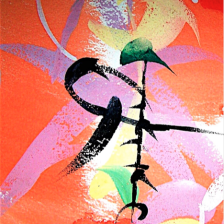
Relief etching on zinc
15-3/4 x 19-5/8 in. Ed. 30 UJ #043
photo: Brooklyn Museum of Art
Yes, a detail of this Peterdi print appears on a record album.
Command Classics used Peterdi’s prints on four of their classical music jackets. They paired DARK VISIT with a fresh recording of Symphonie Fantastique by Berlioz.
![Detail from Peterdi's DARK VISIT used on a Command Classics 35 mm LP record jacket “I just picked up a couple of titles on the Enoch Light produced Command Classics Stereo 35mm series of classical LPs ... The packaging is beautiful. Heavy-weight hardback book style covers with striking, understated art on off-white card stock.” [http://forums.stevehoffman.tv/threads/command-classics-stereo-35mm-lps-recommendations.73614/]](https://i0.wp.com/gaborpeterdi.info/wp-content/uploads/2015/06/Screen-Shot-2015-06-27-at-2.09.53-PM.png?resize=300%2C211)
“I just picked up a couple of titles on the Enoch Light produced Command Classics Stereo 35mm series of classical LPs … The packaging is beautiful. Heavy-weight hardback book style covers with striking, understated art on off-white card stock.” [http://forums.stevehoffman.tv/threads/command-classics-stereo-35mm-lps-recommendations.73614/]
note: Introduced c.1948, LP vinyl records required added protection from scratching, hence a more robust jacket. Now a printable 12.4″ x 12.4″ paperboard surface became available for marketing vinyl records. Early approaches featured dramatic photos of musicians and reproductions of famous paintings.
Original art and typography were not far behind, and from the ’50s to the ’80s a new art form flourished for all record jackets. In the branding of ‘pop culture’ it beautifully accommodated (and may have even prompted) the image-rich names found in the genre: Jefferson Airplane, Iron Maiden, Led Zeppelin, Sex Pistols, Motorhead, Guns ‘n Roses. What would Red Octopus be sans artwork? (It was an album of love songs having nothing to do with the color red nor a cephalopod mollusc—yet its iconic artwork continues to identify Jefferson Starship’s 1975 best-selling album.)
also, this to think about:
The rise of digital music threatens one of the greatest canvasses of art seen in the 20th Century—the record sleeve. Originally just a protective cover … it soon evolved into a space for artistic expression in its own right, very often becoming as important as the music itself. Sometimes, even more so: legend has it that the cover of New Order’s Blue Monday was so expensive to make that their label lost money on every copy sold.[http://www.shortlist.com/entertainment/music/50-coolest-album-covers]
###


![OAHU III. 1968 watercolor on paper [Arches] 26 x 32 in.](https://i0.wp.com/gaborpeterdi.info/wp-content/uploads/2015/07/wc.Oahu-03III1969.jpg?resize=361%2C267)



